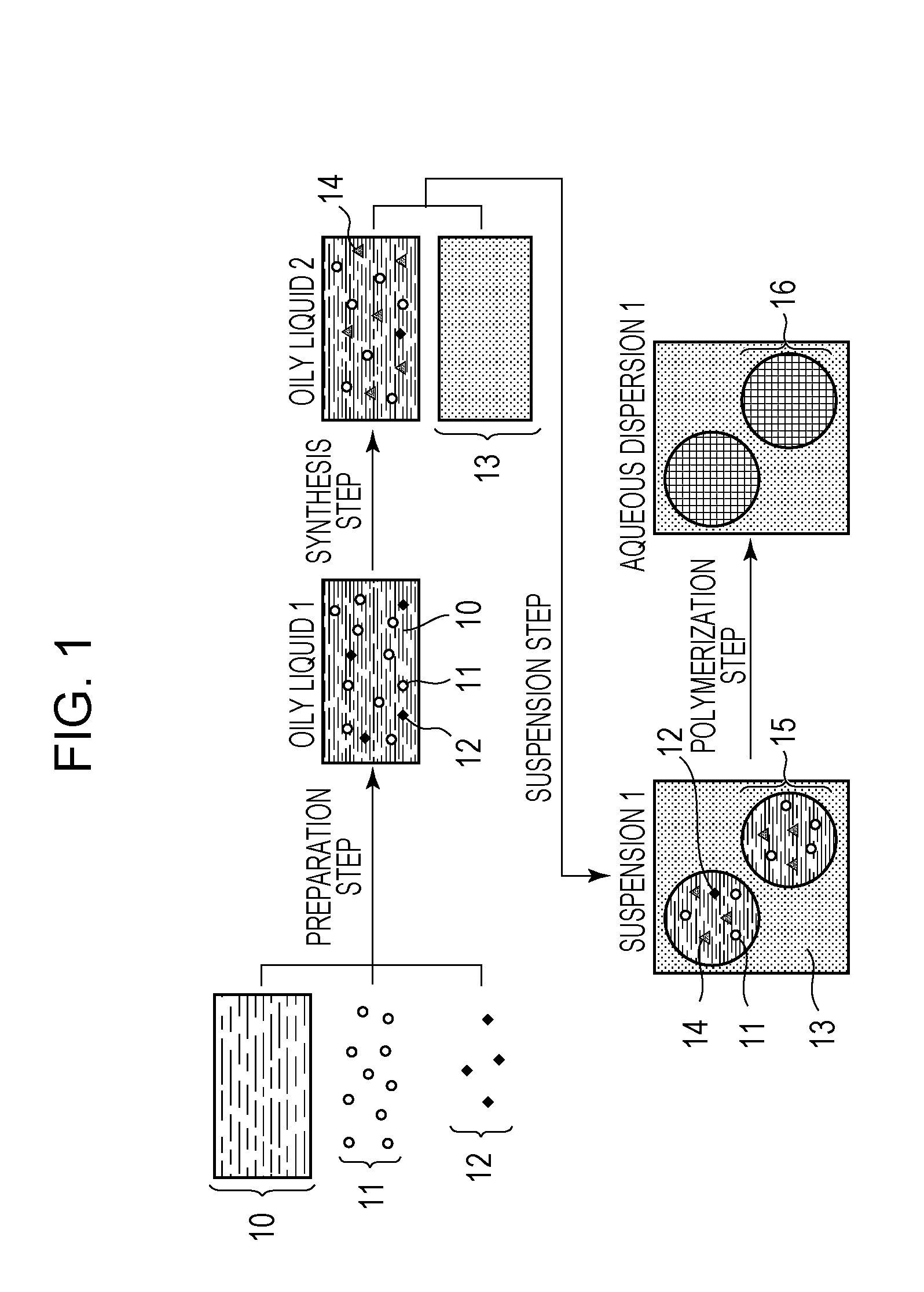Method for producing polymer particles
a polymer and particle technology, applied in the field of polymer particle production, can solve the problems of fundamental insufficient polymerization conversion rate and impaired dispersion stability of polymer particles, and achieve the effect of high polymerization conversion rate and molecular weight controllability
- Summary
- Abstract
- Description
- Claims
- Application Information
AI Technical Summary
Benefits of technology
Problems solved by technology
Method used
Image
Examples
example 1
Preparation Step
[0065]In a 100-mL glass container, 2.0 g of di-sec-butyl peroxydicarbonate (organic peroxide polymerization initiator, 10-hour half-life temperature: 51° C.), 0.7 g of iodine molecules, 2.8 g of a saturated polyester resin (polycondensate of propylene oxide-modified bisphenol A and isophthalic acid, Mw=10,000), and 56.2 g of styrene were charged, and uniformly mixed. A dark purple-red oily liquid 1 was then obtained.
[Synthesis Step]
[0066]Subsequently, nitrogen gas was bubbled through the oily liquid 1 prepared as described above in an ice bath at a flow rate of 200 mL / min for 30 minutes to remove oxygen dissolved in the oily liquid 1, and the oily liquid 1 was then heated to 70° C. in a water bath in a nitrogen atmosphere. After 15 minutes from the start of heating, heating was stopped at the time when the color of the oily liquid 1 changed from the dark purple-red to a light red and thus it was confirmed that a sufficient amount of an iodine compound was produced, a...
example 2
[0070]An aqueous dispersion of polymer particles and polymer particles were obtained as in Example 1 under the conditions of an iodine-molecule reaction rate of the oily liquid 2 of 82% and a viscosity of the oily liquid 2 of 1 mPa·s except that 56.2 g of styrene in Example 1 was changed to 56.2 g of methyl methacrylate.
[0071]The polymerization conversion rate and the particle diameter were measured using the aqueous dispersion of polymer particles. The peak molecular weight (Mp, suspension) and the molecular-weight distribution (Mw / Mn) were measured using a solution prepared by dissolving the polymer particles obtained as a white powder in tetrahydrofuran and removing insoluble matter in the tetrahydrofuran solution by filtration. Furthermore, the molecular-weight controllability was evaluated by comparing the peak molecular weight (Mp, suspension) with the peak molecular weight (Mp, bulk) in Reference Example 2. The results are summarized in Table 1.
example 3
[0072]An aqueous dispersion of polymer particles and polymer particles were obtained as in Example 1 under the conditions of an iodine-molecule reaction rate of the oily liquid 2 of 82% and a viscosity of the oily liquid 2 of 1 mPa·s except that 56.2 g of styrene in Example 1 was changed to 44.7 g of styrene and 11.5 g of methyl methacrylate.
[0073]The polymerization conversion rate and the particle diameter were measured using the aqueous dispersion of polymer particles. The peak molecular weight (Mp, suspension) and the molecular-weight distribution (Mw / Mn) were measured using a solution prepared by dissolving the polymer particles obtained as a white powder in tetrahydrofuran and removing insoluble matter in the tetrahydrofuran solution by filtration. Furthermore, the molecular-weight controllability was evaluated by comparing the peak molecular weight (Mp, suspension) with the peak molecular weight (Mp, bulk) in Reference Example 3. The results are summarized in Table 1.
PUM
| Property | Measurement | Unit |
|---|---|---|
| Fraction | aaaaa | aaaaa |
| Fraction | aaaaa | aaaaa |
| Fraction | aaaaa | aaaaa |
Abstract
Description
Claims
Application Information
 Login to view more
Login to view more - R&D Engineer
- R&D Manager
- IP Professional
- Industry Leading Data Capabilities
- Powerful AI technology
- Patent DNA Extraction
Browse by: Latest US Patents, China's latest patents, Technical Efficacy Thesaurus, Application Domain, Technology Topic.
© 2024 PatSnap. All rights reserved.Legal|Privacy policy|Modern Slavery Act Transparency Statement|Sitemap



